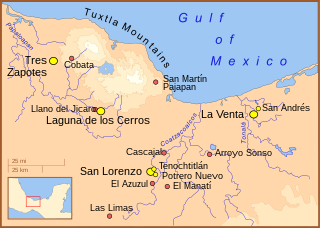
The Olmecs were the earliest known major Mesoamerican civilization. Following a progressive development in Soconusco, they occupied the tropical lowlands of the modern-day Mexican states of Veracruz and Tabasco. It has been speculated that the Olmecs derived in part from the neighboring Mokaya or Mixe–Zoque cultures.

Olmec figurines are archetypical figurines produced by the Formative Period inhabitants of Mesoamerica. While not all of these figurines were produced in the Olmec heartland, they bear the hallmarks and motifs of Olmec culture. While the extent of Olmec control over the areas beyond their heartland is not yet known, Formative Period figurines with Olmec motifs were widespread in the centuries from 1000 to 500 BC, showing a consistency of style and subject throughout nearly all of Mesoamerica.

La Venta is a pre-Columbian archaeological site of the Olmec civilization located in the present-day Mexican state of Tabasco. Some of the artifacts have been moved to the museum "Parque - Museo de La Venta", which is in nearby Villahermosa, the capital of Tabasco.
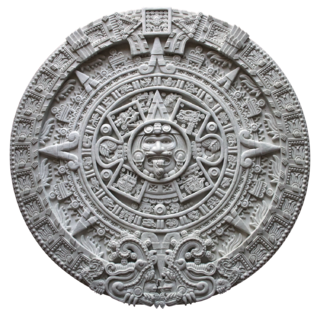
Mesoamerican chronology divides the history of prehispanic Mesoamerica into several periods: the Paleo-Indian ; the Archaic, the Preclassic or Formative (2500 BCE – 250 CE), the Classic (250–900 CE), and the Postclassic (900–1521 CE); as well as the post European contact Colonial Period (1521–1821), and Postcolonial, or the period after independence from Spain (1821–present).

The religion of the Olmec people significantly influenced the social development and mythological world view of Mesoamerica. Scholars have seen echoes of Olmec supernatural in the subsequent religions and mythologies of nearly all later pre-Columbian era cultures.

Teopantecuanitlan is an archaeological site in the Mexican state of Guerrero that represents an unexpectedly early development of complex society for the region. The site dates to the Early to Middle Formative Periods, and archaeological evidence clearly indicates that some kind of connection existed between Teopantecuanitlan and the Olmec heartland of the Gulf Coast. Prior to the discovery of Teopantecuanitlan in the early 1980s, little was known about the region's sociocultural development and organization during the Formative period.

Tlapacoya is an important archaeological site in Mexico, located at the foot of the Tlapacoya volcano, southeast of Mexico City, on the former shore of Lake Chalco. Tlapacoya was a major site for the Tlatilco culture.
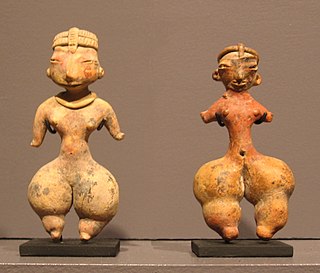
Tlatilco culture is a culture that flourished in the Valley of Mexico between the years 1250 BCE and 800 BCE, during the Mesoamerican Early Formative period. Tlatilco, Tlapacoya, and Coapexco are the major Tlatilco culture sites.

Chiapa de Corzo is an archaeological site of pre-Columbian Mesoamerica located near the small town of Chiapa de Corzo, Chiapas.
Christine Niederberger Betton, born in Bordeaux and died in 2001 in Mexico City, was a French archaeologist. She is mainly noted for her contributions to the field of pre-Columbian American archaeology, in particular for her work on Mesoamerican cultures in central Mexico.
The causes and degree of Olmec influences on Mesoamerican cultures has been a subject of debate over many decades. Although the Olmecs are considered to be perhaps the earliest Mesoamerican civilization, there are questions concerning how and how much the Olmecs influenced cultures outside the Olmec heartland. This debate is succinctly, if simplistically, framed by the title of a 2005 The New York Times article: “Mother Culture, or Only a Sister?”.
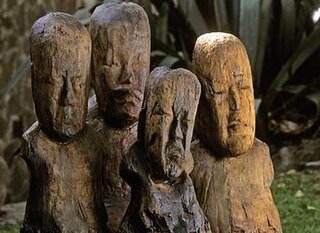
El Manatí is an archaeological site located approximately 60 km south of Coatzacoalcos, in the municipality of Hidalgotitlán 27 kilometers southeast of Minatitlan in the Mexican state of Veracruz. El Manatí was the site of a sacred Olmec sacrificial bog from roughly 1600 BCE until 1200 BCE. It is likely that this site, discovered in 1987, was used for ritual ceremonies which included offerings of wooden sculptures, rubber balls, ceremonial axes, and other items, including the bones of infants – all found in an excellent state of preservation in the muck. Most of the wooden sculptures are busts created in the "elongated man" style and are the oldest wooden artifacts yet found in Mexico. The rubber balls are also the earliest such items yet discovered and were possibly used in the Mesoamerican ballgame.

Remojadas is a name applied to a culture, an archaeological site, as well as an artistic style that flourished on Mexico's Veracruz Gulf Coast from perhaps 100 BCE to 800 CE. The Remojadas culture is considered part of the larger Classic Veracruz culture. Further research into the Remojadas culture is "much needed". The archaeological site has remained largely unexplored since the initial investigations by Alfonso Medellin Zenil in 1949 and 1950.
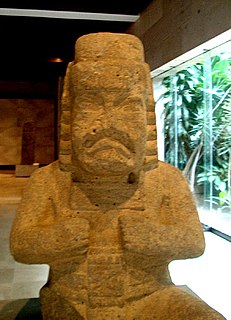
The were-jaguar was both an Olmec motif and a supernatural entity, perhaps a deity.

The Feathered Serpent was a prominent supernatural entity or deity, found in many Mesoamerican religions. It is still called Quetzalcoatl among the Aztecs, Kukulkan among the Yucatec Maya, and Q'uq'umatz and Tohil among the K'iche' Maya.

Classic Veracruz culture refers to a cultural area in the north and central areas of the present-day Mexican state of Veracruz, a culture that existed from roughly 100 to 1000 CE, or during the Classic era.

The Western Mexico shaft tomb tradition refers to a set of interlocked cultural traits found in the western Mexican states of Jalisco, Nayarit, and, to a lesser extent, Colima to its south, roughly dating to the period between 300 BCE and 400 CE, although there is not wide agreement on this end date. Nearly all of the artifacts associated with this shaft tomb tradition have been discovered by looters and are without provenance, making dating problematic.
Olmec hieroglyphs designate a possible system of writing or proto-writing developed within the Olmec culture. The Olmecs were the earliest known major Mesoamerican civilization, flourishing during the formative period in the tropical lowlands of the modern-day Mexican states of Veracruz and Tabasco. The subsequent Epi-Olmec culture, was a successor culture to the Olmec and featured a full-fledged writing system, the Isthmian script.

Xochipala is a minor archaeological site in the Mexican state of Guerrero, whose name has become attached, somewhat erroneously, to a style of Formative Period figurines and pottery from 1500 to 200 BCE. The archaeological site belongs to the Classic and Postclassic eras, from 200-1400 CE.
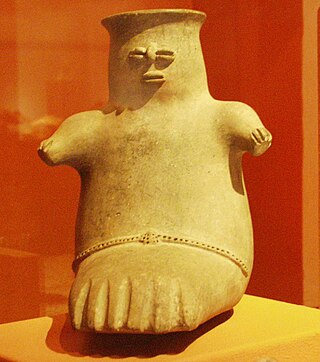
Chupícuaro is an important prehispanic archeological site from the late preclassical or formative period. The culture that takes its name from the site dates to 400 BC to 200 AD, or alternatively 500 BC to 300 AD., although some academics suggest an origin as early as 800 BC.



















